Meet The Technicians
Meet the Repair Technicians
Gary McCheyne
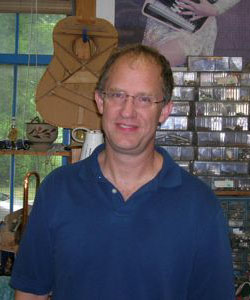 After finishing his Master's degree in music and playing professionally in the New York City Metropolitan area, Gary settled in behind his bench at Hickey's in 1990. With a degree in Fine Arts and a passion for making musical instruments, repair of string instruments and brasswinds came naturally. Gary is a member of the National Association of Professional Band Instrument Repair Technicians (NAPBIRT) and a member of the American Guild of Luthiers. He routinely attends seminars and workshops on advanced repairs techniques. His clientel come from all over the United States and includes an impressive list of major performers. Whether it's an antique restoration of a trombone from Hawaii, a violin from Denver, or a ¼ cello for a local 4th grader, Gary says he treats them all seriously. "My job is to help the artist be their best. That means keeping their instrument in its best playing condition." Recently, jazz legend Donald Byrd brought all of his trumpets up from New York City just to have Gary "make them right!"
After finishing his Master's degree in music and playing professionally in the New York City Metropolitan area, Gary settled in behind his bench at Hickey's in 1990. With a degree in Fine Arts and a passion for making musical instruments, repair of string instruments and brasswinds came naturally. Gary is a member of the National Association of Professional Band Instrument Repair Technicians (NAPBIRT) and a member of the American Guild of Luthiers. He routinely attends seminars and workshops on advanced repairs techniques. His clientel come from all over the United States and includes an impressive list of major performers. Whether it's an antique restoration of a trombone from Hawaii, a violin from Denver, or a ¼ cello for a local 4th grader, Gary says he treats them all seriously. "My job is to help the artist be their best. That means keeping their instrument in its best playing condition." Recently, jazz legend Donald Byrd brought all of his trumpets up from New York City just to have Gary "make them right!"
Manuel Antonio Matta Baeza
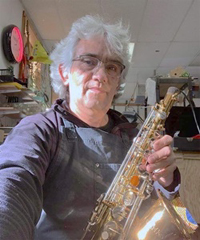 Passionate and dedicated Woodwind Instrument Repairman with over 20 years of experience repairing, restoring, and adjusting woodwind and brass instruments. Manuel had professional training at Selmer-Paris, France, where he gained technical training for repairing saxophones, clarinets, and brass instruments. He was also the founder and owner of the first professional repair shop dedicated exclusively to woodwind instruments in Santiago, Chile. Manuel has always looked for ways to improve his professional repairman skills. In 2013, he became a member of the National Association of Professional Band Instrument Repair Technicians (NAPBIRT). Soon after, Manuel began an internship in Boston, Massachusetts, to gain personal training with Master Emilio Lyons. In 2014, he moved to New York City, where he became Repair Assistant at Roberto's Winds, a position he held until March 2020, when Covid-19 impacted NYC. At the same time that Manuel was developing his career as a woodwind instrument repairman, he was also the saxophonist at the Latin American pop music band Los Galos for 24 years. He still enjoys playing the saxophone in his free time.
Passionate and dedicated Woodwind Instrument Repairman with over 20 years of experience repairing, restoring, and adjusting woodwind and brass instruments. Manuel had professional training at Selmer-Paris, France, where he gained technical training for repairing saxophones, clarinets, and brass instruments. He was also the founder and owner of the first professional repair shop dedicated exclusively to woodwind instruments in Santiago, Chile. Manuel has always looked for ways to improve his professional repairman skills. In 2013, he became a member of the National Association of Professional Band Instrument Repair Technicians (NAPBIRT). Soon after, Manuel began an internship in Boston, Massachusetts, to gain personal training with Master Emilio Lyons. In 2014, he moved to New York City, where he became Repair Assistant at Roberto's Winds, a position he held until March 2020, when Covid-19 impacted NYC. At the same time that Manuel was developing his career as a woodwind instrument repairman, he was also the saxophonist at the Latin American pop music band Los Galos for 24 years. He still enjoys playing the saxophone in his free time.
Noah Stroka
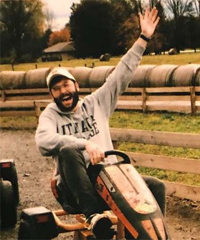 Noah Stroka is an Instrument Technician and bassoonist from Binghamton, NY. Noah has received an AAS in Band Instrument Repair from Minnesota State Southeast (Redwing) in 2021, and will receive a BA in Instrumental Music - Bassoon from Ithaca College in 2022. Aside from music, Noah has an interest in visual art and likes to sculpt and draw.
Noah Stroka is an Instrument Technician and bassoonist from Binghamton, NY. Noah has received an AAS in Band Instrument Repair from Minnesota State Southeast (Redwing) in 2021, and will receive a BA in Instrumental Music - Bassoon from Ithaca College in 2022. Aside from music, Noah has an interest in visual art and likes to sculpt and draw.
Kellen Ko
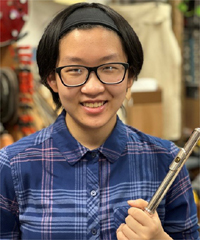 Kellen is a third-year Music Education & Flute Performance double major at Ithaca College. Originally from Oregon, Kellen's interest in instrument repair started in high school from watching a local flute technician at work. They have experienced first-hand how a properly maintained instrument could transform your musicianship and confidence. Kellen is currently apprenticing under Gary McCheyne. Aside from instrument repair, Kellen is also an active flutist and music educator.
Kellen is a third-year Music Education & Flute Performance double major at Ithaca College. Originally from Oregon, Kellen's interest in instrument repair started in high school from watching a local flute technician at work. They have experienced first-hand how a properly maintained instrument could transform your musicianship and confidence. Kellen is currently apprenticing under Gary McCheyne. Aside from instrument repair, Kellen is also an active flutist and music educator.
William Hurley
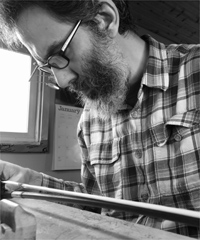 William Hurley (wthurley.com) is trained in bow repair and restoration by bowmaker Geo Kloppel. He seeks to bring patient attention and rigorous standards to each bow in his care, and looks forward to serving the Ithaca community and beyond. He performs on viola and violin with Music’s Recreation (musicsrecreation.org), The Tarragon Duo, The Binghamton Philharmonic, The Tri-Cities Opera Orchestra, and in other collaborations. He teaches through the Community School of Music and Arts and independently, and works as a violinmaker. He lives in the hills of Danby.
William Hurley (wthurley.com) is trained in bow repair and restoration by bowmaker Geo Kloppel. He seeks to bring patient attention and rigorous standards to each bow in his care, and looks forward to serving the Ithaca community and beyond. He performs on viola and violin with Music’s Recreation (musicsrecreation.org), The Tarragon Duo, The Binghamton Philharmonic, The Tri-Cities Opera Orchestra, and in other collaborations. He teaches through the Community School of Music and Arts and independently, and works as a violinmaker. He lives in the hills of Danby.
